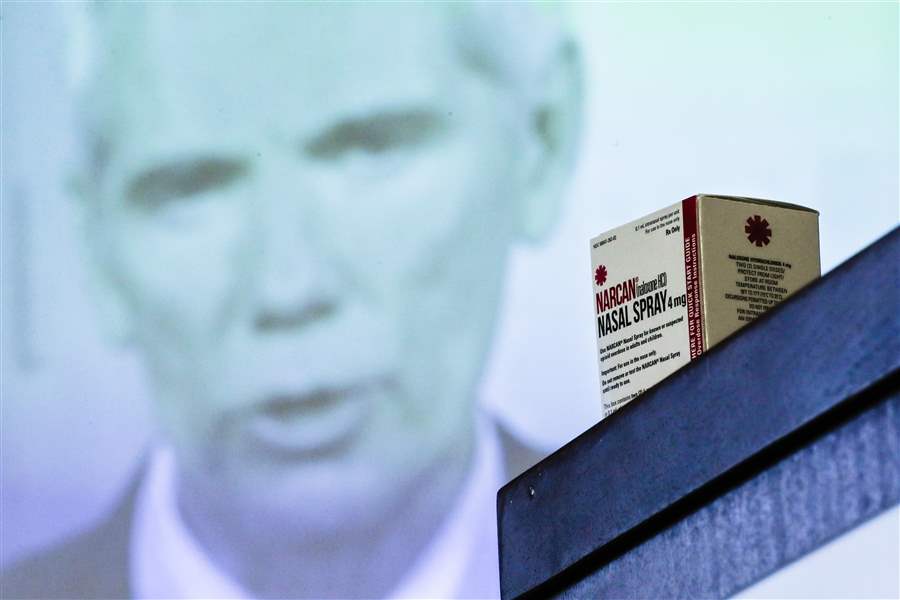
Get moving on STOP to fight fentanyl
9/13/2017
Sen. Rob Portman, R-Ohio, is shown via a prepared video projection during a news conference to announce a program and pilot study in Hamilton County to more than quadruple distribution of the opioid overdose-reversing drug Narcan to 30,000 units in nasal spray form on Thursday in Cincinnati.
ASSOCIATED PRESS
In February, Sen. Rob Portman (R., Ohio) and U.S. Rep. Pat Tiberi (R., Columbus) targeted the deadly synthetic opioid fentanyl by introducing versions of the Synthetics Trafficking and Overdose Prevention Act in the Senate and the House of Representatives.
The bills have inexplicably languished in Congress. But a recent Ohio report must add a sense of urgency for lawmakers.
Click here to read more Blade editorials
The Ohio Department of Health reported recently that unintentional drug overdoses killed 4,050 people in 2016, a sharp spike of 1,000 deaths from the previous year. More than 50 percent of the deaths are from fentanyl.
The overall numbers, though sobering, were not surprising. Overdose deaths have climbed steadily since 2011. The numbers will likely be even higher for 2017, with Montgomery County alone estimating that 800 people will die from overdoses this year.
What was somewhat surprising is that heroin deaths have leveled off and prescription opioids killed fewer people in 2016 than 2015. In a thunderstorm, that would be the equivalent of going from torrential rain to just a hard rain, but it is a ray of hope.
The main culprit is now fentanyl, a painkiller that was first used in 1960 for cardiac surgery. It is 50 times more potent than heroin and is a much bigger moneymaker than heroin. A June report from the Lucas County Coroner’s Office indicated that fentanyl, for the first time, is causing more deaths than heroin in northwest Ohio and southeast Michigan.
It is easy to see why the drug is popular among drug dealiers. It produces a shorter high than heroin, meaning more trips to the dealer. And Orman Hall, an analyst with the Ohio High Intensity Drug Trafficking Area task force, told the Columbus Dispatch that a kilogram of heroin amounts to 10,000 doses on the street, but the same amount of fentanyl makes 500,000 doses.
The STOP Act would enable closer inspection of overseas packages arriving through the U.S. Postal Service. Unlicensed pharmacies in China and Mexico illegally produce fentanyl and often ship it to the United States through the Postal Service, which does not require as stringent of shipping information as FedEx or UPS. Ohio is a popular landing spot for the drug because of the wealth of interstates that allow for easy distribution.
The STOP Act would be a valuable tool for Customs officials hoping to stem the flood of fentanyl into the country. Red flags would be raised for inspectors by incomplete information or recurring deliveries from the same location.
In recent years, the surge in overdose deaths in Ohio — and the country — has been linked to heroin and opioids. But the main culprit now is fentanyl, a deadlier and even more addictive drug. The STOP Act is one way to combat the flow of the drug into the marketplace. The bills received bipartisan support upon introduction in both houses of Congress. There is little objection to them. The recent Ohio report proves that lawmakers need to act with a sense of urgency.